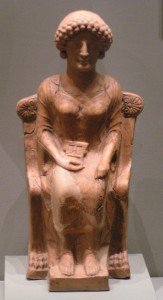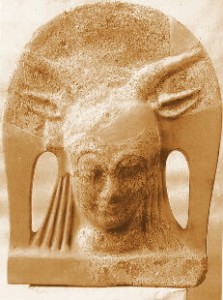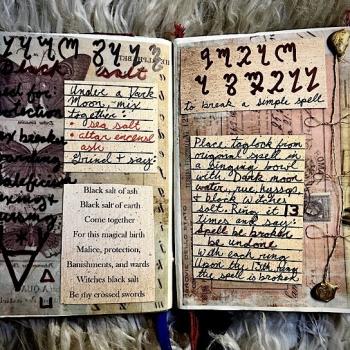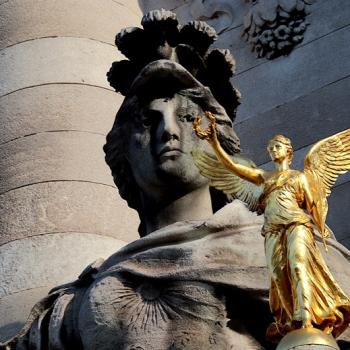The Kalends of February honors Juno Sospita of Lanuvium. She is called the Queen of Heaven, our Heavenly Mother, and Savior. Juno Sospita is generally depicted armed with a shield and spear. Her long gown is covered by a goat skin that is drawn up with the horns on Her head. Her temple stood high atop the acropolis at Lanuvium, , where She was probably named Catana, the Goddess of Good Wisdom. In Her attributes She is similar to Athene atop the acropolis of Athens. At Rome both Catana and Athene were known as Minerva. A reference to a temple for Minerva Medica on the Esquiline Hill may have referred to Juno Sospita since this is the location where one of Her temples once stood (Cicero de Div. II.123; CIL VI.10133, VI. 30980).
In 338 bce Rome took Lanuvium, accepting its people as citizens of Rome and honoring their Gods and Goddesses. As Rome did with Etruscan Vei and later with Tanit of Carthage, Rome honored the juno of the Goddess. Just as every man has his own unique genius, and every woman her own divine spirit called her juno, so also every Goddess has Her own female essence called a juno. Thus we find Proerpina called Juno of Enna, or sometimes She is known as the chthonic Juno. Vei became Juno Regina of the Aventine Hill in Rome, while another temple at Rome was dedicated to a different Juno Regina represented Tanit. Simply because a Goddess is worshiped by Her Juno, it does not mean that She is the same Goddess as Juno Capitolina, the consort of Jupiter, who in all likelihood was probably Ceres. It was not until 197 bce that Catana received a temple in Rome itself, as Juno Sospita on the Esquiline Hill. She was seated there along with Juno Lucina, who was Diana Nemorensis of Aricia (Pliny NH 16.85; Dionys 4.1.5; Ovid, Fasti 2.435-436), and with the widowed Juno, who was brought to Rome by the Sabines as Mefula (Fest. 348; Ovid Fasti 3.245-246; Varro L. L. v.49), as well as groves for the Nymphae, the Fevers, and related Goddesses of healing.
During the Social War (90 bce) Caecilia Metellus dreamt that Juno Sospita was angry and would soon depart Rome for Her city of Lanuvium. The Goddess, prophesised to Caecilia that disaster would come to the health of Romans and Her prophesies soon began to come true. Caecilia awoke and immediately rushed to the temple. There she found that the women of the City had been using the temple as a lavatory and that a dog had whelped her pups at the foot of the Goddess’ statue. Caecilia thus saw to it that the temple was cleansed, purified, and restored, before inviting Juno Sospita to return. Thereby Caecilia gained famed as a woman who had saved Rome (Cicero De Div. 1.99).
Da mihi hasce opes, quas peto, quas precor porrige opitula.
Grant me the strength, Goddess, to whom I ask, to whom I pray; extend your assistance to me.”

Also celebrated on the Kalends of February is Juno Februa. The month of February is the last month of the Roman sacrificial year and thus it is dedicated to purification in anticipation of the New Year. The word februa refers to anything that is used in purification rites. A ceremony was held where the flamenica Dialis, who was the wife of the priest of Jupiter, would ask for februa from the rex sacrorum who represented the priest-kings after Numa Pompilius. In return she received a bough of pine. Other priests were give woolen fillets as their februa, or else wreathes of laurel to crown their heads. Houses are cleaned, the front door is washed down and then wiped with februa using a measuring motion, the hinges are dabbed with olive oil or wolf fat using a bough of arbutus or mulberry, and three leaves from the same tree is placed on the threshold. Offerings for Juno Februa are then placed on the door sill outside the house. Offered to Her are roasted kernels of spelt, salt, milk, honey, water, and a lighted candle. This ritual honors the Juno who is the minor goddess, associated with Janus Janitor. Both guard the door of the house, with Juno Februa holding off all evils from the home, whether the evil is disease, false rumors, or the jealousy of neighbors. Think of the home as the temple of the family. One starts the month of purification outside the house, at the front door representing the boundary of the whole, and then over the weeks ahead one proceeds to clean and purify the rest of the home. The kalends of every month are dedicated to Janus and Juno, and thus the same offerings should be provided every month at this time, but in February there is a special emphasis to purify the home and renew it as the residence of our ancestors and our household Gods and Goddesses.
















